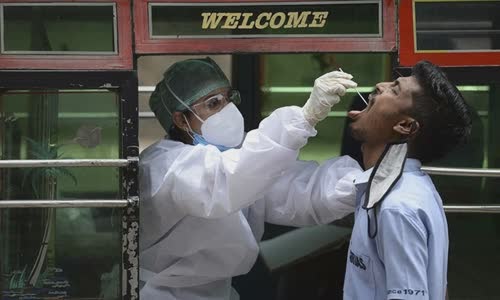Globally, more than 42.4 million people have been infected with nCoV, of which more than 1.1 million people died, the epidemic situation in the US and Europe is complicated.
215 countries and territories recorded 42,439,636 cases and 1,148,492 deaths from nCoV, an increase of 506,770 and 6,985 cases after 24 hours, while 31,409,989 people recovered, according to the site's statistics.

Medical staff sample Covid-19 outside a shopping mall in Chennai, India, September 12 Photo: AFP
The US, the world's largest epidemic zone, recorded 8,735,747 cases and 229,210 deaths, an increase of 83,509 and 935 cases compared to the day before.
Pennsylvania, South Dakota, Tennessee, Alaska, Ohio and Utah recorded a record high of new infections on October 23.
Chicago Mayor Lori E. Lightfoot ordered a curfew on non-essential business from 10 p.m.
India, the world's second largest epidemic region, reported an additional 54,028 infections and 656 deaths, bringing the total number of people infected and dead from Covid-19 to 7,813,668 and 117,992 respectively.
In a televised address on October 20, Indian Prime Minister Narendra Modi announced that the government is working hard to ensure the provision of Covid-19 vaccine to all citizens once the vaccine is ready.
Officials said on October 23 that India is urgently preparing a database of all public and private health workers to quickly vaccinate them as soon as the vaccine becomes available.
Brazil, the third largest epidemic region in the world, recorded an additional 509 deaths from Covid-19, bringing the total number of deaths to 156,471.
Brazil's health regulator Anvisa on October 23 allowed the Butantan Institute of Sao Paulo to import 6 million doses of the vaccine from the Chinese company Sinovac, although President Bolsonaro said in midweek that Brazil would not buy the Chinese vaccine.
Russia recorded an additional 283 deaths, bringing the total number of deaths to 25,525, while the number of infections increased by 17,340, to 1,480,646.
Although the epidemic tends to be complicated, Russian officials have eliminated the possibility of re-imposing strict blockade measures like earlier this year.
Total new infections in Europe more than doubled in the past 10 days, exceeding 200,000 new infections a day on October 22.
Spain recorded 1,110,372 cases and 34,521 deaths, up 19,851 and 231 respectively.
Prime Minister Pedro Sanchez said on October 23 that "the number of people infected" in Spain is three million.
France recorded an additional 42,032 cases of nCoV infection, bringing the total to 1,041,075 cases, of which 34,508 died, an increase of 298 cases.
President Emmanuel Macron issued a curfew in Paris and eight other major cities for six weeks, starting October 17.
French Prime Minister Jean Castex on October 22 announced to extend the order to more than 2/3 of the country's population.
He recorded 830,998 cases and 44,571 deaths, up 20,530 and 224 cases respectively.
About 3.1 million people in Wales have to stay home from 6pm for 17 days, starting October 23.
British Prime Minister Boris Johnson said last week that a new nationwide blockade would be "catastrophic", but did not eliminate this possibility as the situation progresses increasingly complicated.
South Africa, the world's 12th largest epidemic region and the country most severely affected by the pandemic in Africa, recorded 712,412 cases and 18,891 deaths, up 1,897 and 48 respectively.
The South African government decided to open borders with most countries from October 1, while gradually loosening the world's top strict restrictions, in an effort to revive the economy.
Cases have risen sharply in the West Cape province over the past two weeks.
Iran, the Middle East's largest epidemic region, reported 31,985 deaths, an increase of 335, while the total number of infections was 556,891, an increase of 6,134.
Iran is planning to impose new restrictions, including allowing odd-day civil servants to work in the capital, Tehran, or setting different hours of work in industries to reduce crowding on the roads.
In Southeast Asia, Indonesia is the region's largest epidemic with 381,910 cases, an increase of 4,369 from the previous day, of which 13,077 died, an increase of 118 cases.
Jakarta started to impose restrictions to prevent nCoV in early April and then loosen it up in June. However, weeks later, the number of new infections in the capital skyrocketed.
The Philippines reported 365,799 cases and 6,915 deaths, up 1,923 and 132 cases respectively.
Most businesses have been reopened since the end of the blockade on August 19 in Manila.
Updated: 7: 6, 24/10 | Source: WorldOMeters



 Mary Cox Morris
Mary Cox Morris







